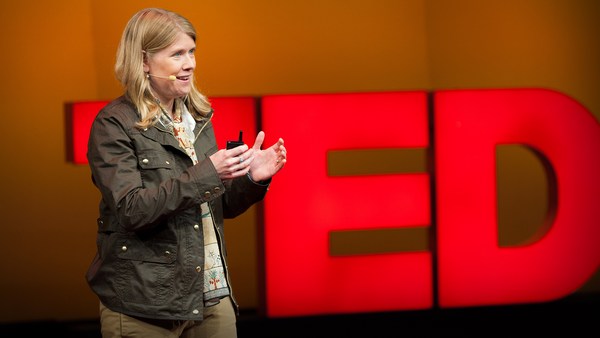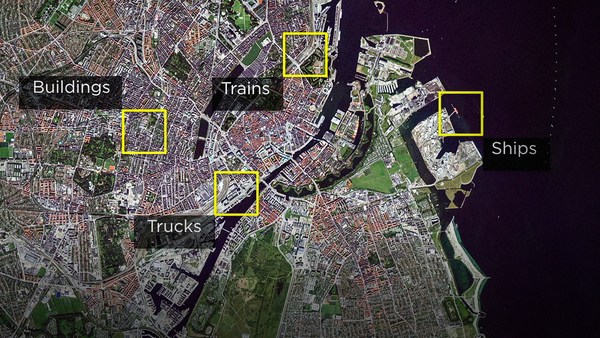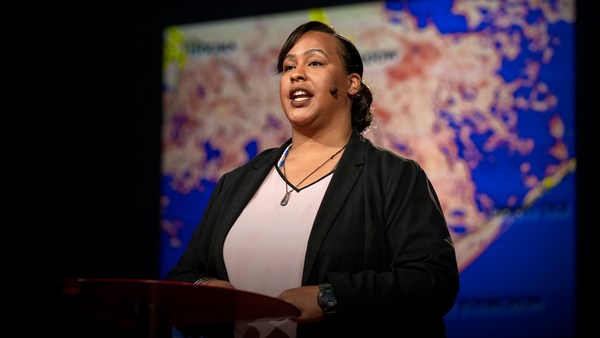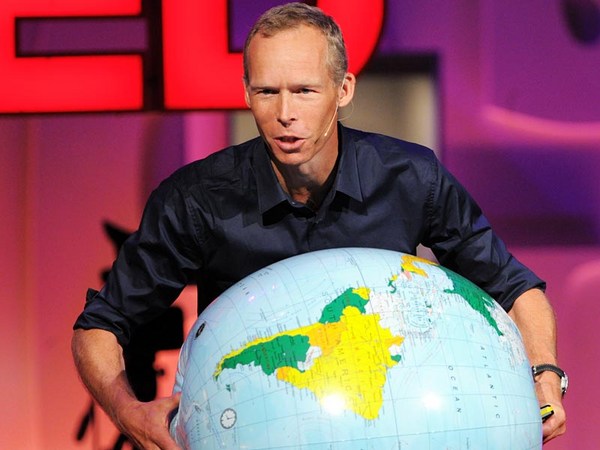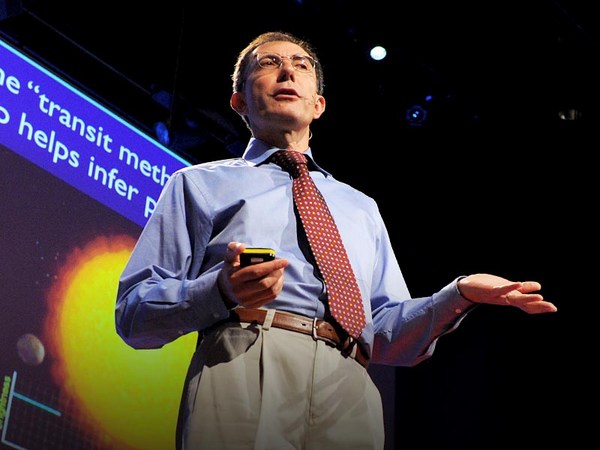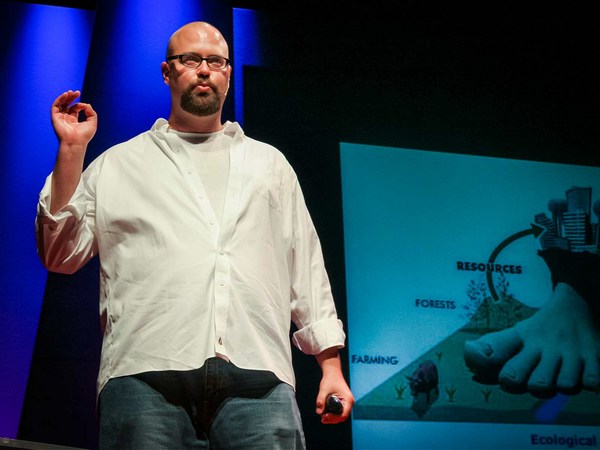The most astounding place I've ever been is the Mosquitia Rain Forest in Honduras. I've done archaeological fieldwork all over the world, so I thought I knew what to expect venturing into the jungle, but I was wrong. For the first time in my life, I might add.
(Laughter)
First of all, it's freezing. It's 90 degrees, but you're soaking wet from the humidity, and the canopy of trees is so thick that sunlight never reaches the surface. You can't get dry. Immediately, I knew that I hadn't brought enough clothing. That first night, I kept feeling things moving underneath my hammock, unknown creatures brushing and poking against the thin nylon fabric. And I could barely sleep through all the noise. The jungle is loud. It's shockingly loud. It's like being downtown in a bustling city.
As the night wore on, I became increasingly frustrated with my sleeplessness, knowing I had a full day ahead. When I finally got up at dawn, my sense of unseen things was all too real. There were hoofprints, paw prints, linear snake tracks everywhere. And what's even more shocking, we saw those same animals in the daylight, and they were completely unafraid of us. They had no experience with people. They had no reason to be afraid.
As I walked toward the undocumented city, my reason for being there, I realized that this was the only place that I had ever been where I didn't see a single shred of plastic. That's how remote it was. Perhaps it's surprising to learn that there are still places on our planet that are so untouched by people, but it's true. There are still hundreds of places where people haven't stepped for centuries or maybe forever.
It's an awesome time to be an archaeologist. We have the tools and the technology to understand our planet like never before. And yet, we're running out of time. The climate crisis threatens to destroy our ecological and cultural patrimony. I feel an urgency to my work that I didn't feel 20 years ago. How can we document everything before it's too late?
I was trained as a traditional archaeologist using methodologies that have been around since the '50s. That all changed in July of 2009 in Michoacán, Mexico. I was studying the ancient Purépecha Empire, which is a lesser known but equally important contemporary of the Aztec. Two weeks earlier, my team had documented an unknown settlement, so we were painstakingly mapping, building foundations by hand -- hundreds of them.
Basic archaeological protocol is to find the edge of a settlement so you know what you're dealing with, and my graduate students convinced me to do just that. So I grabbed a couple of CLIF Bars, some water, a walkie, and I set out alone on foot, expecting to encounter "the edge" in just a few minutes. A few minutes passed. And then an hour. Finally, I reached the other side of the malpais. Oh, there were ancient building foundations all the way across. It's a city? Oh, shit.
(Laughter)
It's a city.
Turns out that this seemingly small settlement was actually an ancient urban megalopolis, 26 square kilometers in size, with as many building foundations as modern-day Manhattan, an archaeological settlement so large that it would take me decades to survey fully, the entire rest of my career, which was exactly how I didn't want to spend the entire rest of my career --
(Laughter)
sweating, exhausted, placating stressed-out graduate students --
(Laughter)
tossing scraps of PB and J sandwiches to feral dogs, which is pointless, by the way, because Mexican dogs really don't like peanut butter.
(Laughter)
Just the thought of it bored me to tears.
So I returned home to Colorado, and I poked my head through a colleague's door. "Dude, there's gotta be a better way." He asked if I had heard of this new technology called LiDAR -- Light Detection And Ranging. I looked it up. LiDAR involves shooting a dense grid of laser pulses from an airplane to the ground's surface. What you end up with is a high-resolution scan of the earth's surface and everything on it. It's not an image, but instead it's a dense, three-dimensional plot of points. We had enough money in the scan, so we did just that. The company went to Mexico, they flew the LiDAR and they sent back the data.
Over the next several months, I learned to practice digital deforestation, filtering away trees, brush and other vegetation to reveal the ancient cultural landscape below.
When I looked at my first visualization, I began to cry, which I know comes as quite a shock to you, given how manly I must seem.
(Laughter)
In just 45 minutes of flying, the LiDAR had collected the same amount of data as what would have taken decades by hand: every house foundation, building, road and pyramid, incredible detail, representing the lives of thousands of people who lived and loved and died in these spaces. And what's more, the quality of the data wasn't comparable to traditional archaeological research. It was much, much better. I knew that this technology would change the entire field of archaeology in the coming years, and it did.
Our work came to the attention of a group of filmmakers who were searching for a legendary lost city in Honduras. They failed in their quest, but they instead documented an unknown culture, now buried under a pristine wilderness rain forest, using LiDAR. I agreed to help interpret their data, which is how I found myself deep in that Mosquitia jungle, plastic-free and filled with curious animals.
Our goal was to verify that the archaeological features we identified in our LiDAR were actually there on the ground, and they were. Eleven months later, I returned with a crack team of archaeologists sponsored by the National Geographic Society and the Honduran government. In a month, we excavated over 400 objects from what we now call the City of the Jaguar.
We felt a moral and ethical responsibility to protect this site as it was, but in the short time that we were there, things inevitably changed. The tiny gravel bar where we first landed our helicopter was gone. The brush had been cleared away and the trees removed to create a large landing zone for several helicopters at once. Without it, after just one rainy season, the ancient canals that we had seen in our LiDAR scan were damaged or destroyed. And the Eden I described soon had a large clearing, central camp, lights and an outdoor chapel. In other words, despite our best efforts to protect the site as it was, things changed. Our initial LiDAR scan of this City of the Jaguar is the only record of this place as it existed just a few years ago.
And broadly speaking, this is a problem for archaeologists. We can't study an area without changing it somehow, and regardless, the earth is changing. Archaeological sites are destroyed. History is lost.
Just this year, we watched in horror as the Notre Dame Cathedral went up in flames. The iconic spire collapsed, and the roof was all but destroyed. Miraculously, the art historian Andrew Tallon and colleagues scanned the cathedral in 2010 using LiDAR. At the time, their goal was to understand how the building was constructed. Now, their LiDAR scan is the most comprehensive record of the cathedral, and it'll prove invaluable in the reconstruction. They couldn't have anticipated the fire or how their scan would be used, but we're lucky to have it.
We take for granted that our cultural and ecological patrimony will be around forever. It won't. Organizations like SCI-Arc and Virtual Wonders are doing incredible work to record the world's historic monuments, but nothing similar exists for the earth's landscapes. We've lost 50 percent of our rain forests. We lose 18 million acres of forest every year. And rising sea levels will make cities, countries and continents completely unrecognizable. Unless we have a record of these places, no one in the future will know they existed. If the earth is the Titanic, we've struck the iceberg, everyone's on deck and the orchestra is playing. The climate crisis threatens to destroy our cultural and ecological patrimony within decades. But sitting on our hands and doing nothing is not an option. Shouldn't we save everything we can on the lifeboats?
(Applause)
Looking at my scans from Honduras and Mexico, it's clear that we need to scan, scan, scan now as much as possible, while we still can. That's what inspired the Earth Archive, an unprecedented scientific effort to LiDAR-scan the entire planet, starting with areas that are most threatened.
Its purpose is threefold. Number one: create a baseline record of the earth as it exists today to more effectively mitigate the climate crisis. To measure change, you need two sets of data: a before and an after. Right now, we don't have a high-resolution before data set for much of the planet, so we can't measure change, and we can't evaluate which of our current efforts to combat the climate crisis are making a positive impact.
Number two: create a virtual planet so that any number of scientists can study our earth today. Archaeologists like me can look for undocumented settlements. Ecologists can study tree size, forest composition and age. Geologists can study hydrology, faults, disturbance. The possibilities are endless.
Number three: preserve a record of the planet for our grandchildren's grandchildren, so they can reconstruct and study lost cultural patrimony in the future. As science and technology advance, they'll apply new tools, algorithms, even AI to LiDAR scans done today, and ask questions that we can't currently conceive of.
Like Notre Dame, we can't imagine how these records will be used. But we know that they'll be critically important. The Earth Archive is the ultimate gift to future generations, because the truth be told, I won't live long enough to see its full impact, and neither will you. That's exactly why it's worth doing. The Earth Archive is a bet on the future of humanity. It's a bet that together, collectively, as people and as scientists, that we'll face the climate crisis and that we'll choose to do the right thing, not just for us today but to honor those who came before us and to pay it forward to future generations who will carry on our legacy.
Thank you.
(Applause)
